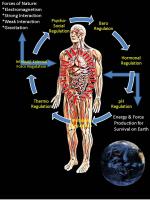|
This section contains 543 words (approx. 2 pages at 300 words per page) |

|
Living things are incredibly complex. They are constantly using and creating energy with countless cellular reactions. An organism must constantly maintain conditions which are favorable for these reactions to occur. The internal state of every living thing must be kept fairly constant. Homeostasis is the maintenance of internal conditions within certain boundaries.
The concept of homeostasis was developed by a French physiologist, Claude Bernard, in 1851. He was the first to recognize the presence and relative constancy of an organism's internal environment, which he called the milieu intérieur, while living in an ever-changing external environment, or milieu extérieur. An organism needed to maintain a dynamically constant internal environment in order to survive. Shortly after Bernard's pioneering work, an American physiologist, Walter Cannon (1871-1945), coined the term homeostasis, referring to this internal dynamic constancy.
An organism has many mechanisms and structures for maintaining homeostasis. Some of...
|
This section contains 543 words (approx. 2 pages at 300 words per page) |

|


